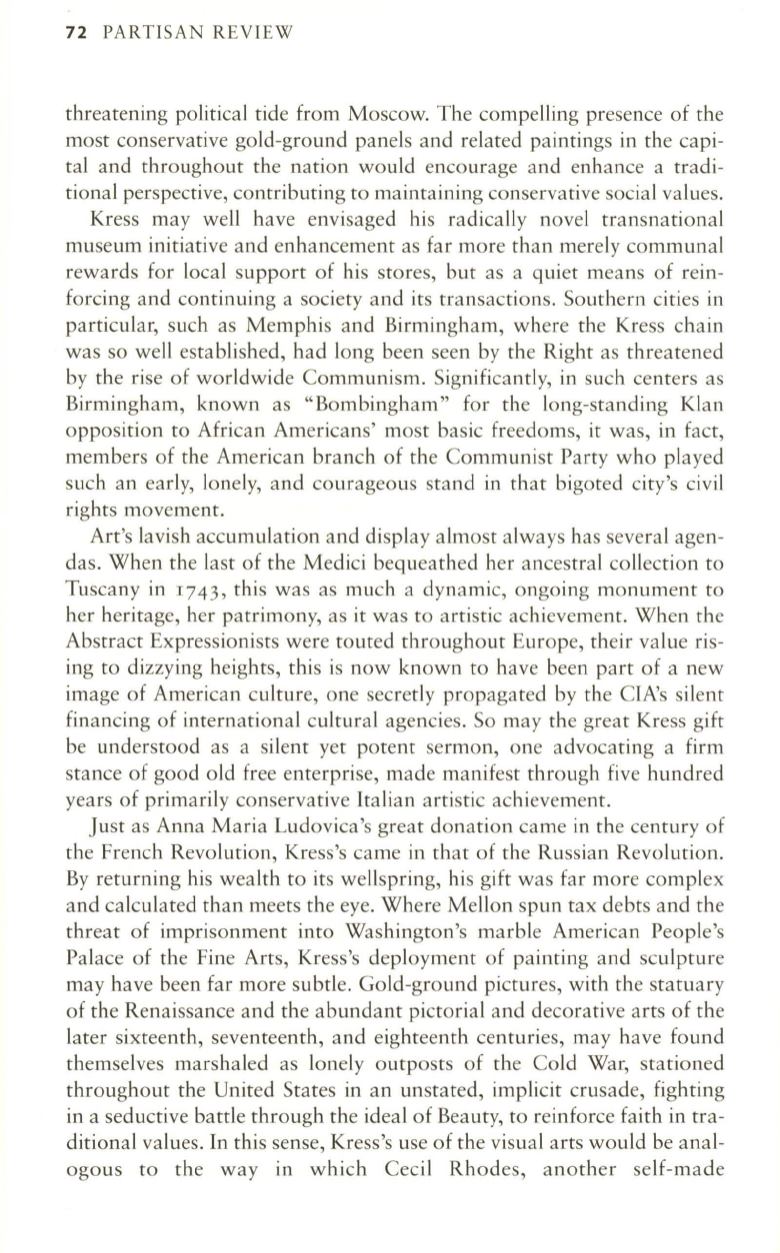
72
PARTISAN REVIEW
threatening political tide from Moscow. The compelling presence of the
most conservative gold-ground panels and related paintings in the capi–
tal and throughout the nation would encourage and enhance a tradi–
tional perspective, contributing to maintaining conservative social values.
Kress may well have envisaged his radically novel transnational
museum initiative and enhancement as far more than merely communal
rewards for local support of his stores, but as a quiet means of rein–
forcing and continuing a society and its transactions. Southern cities in
particular, such as Memphis and Birmingham, where the Kress chain
was so well established, had long been seen by the Right as threatened
by the rise of worldwide Communism. Significantly, in such centers as
Birmingham, known as "Bombingham" for the long-standing Klan
opposition to African Americans' most basic freedoms, it was, in fact,
members of the American branch of the Communist Party who played
such an early, lonely, and courageous stand in that bigoted city's civil
rights movement.
Art's lavish accumulation and display almost always has several agen–
das. When the last of the Medici bequeathed her ancestral collection to
Tuscany in 1743, this was as much a dynamic, ongoing monument to
her heritage, her patrimony, as it was to artistic achievement. When the
Abstract Expressionists were touted throughout Europe, their value ris–
ing to dizzying heights, this is now known to have been part of a new
image of American culture, one secretly propagated by the CIA's silent
financing of international cultural agencies. So may the great Kress gift
be understood as a silent yet potent sermon, one advocating a firm
stance of good old free enterprise, made manifest through five hundred
years of primarily conservative Italian artistic achievement.
Just as Anna Maria Ludovica's great donation came in the century of
the French Revolution, Kress's came in that of the Russian Revolution.
By returning his wealth to its wellspring, his gift was far more complex
and calculated than meets the eye. Where Mellon spun tax debts and the
threat of imprisonment into Washington's marble American People's
Palace of the Fine Arts, Kress's deployment of painting and sculpture
may have been far more subtle. Gold-ground pictures, with the statuary
of the Renaissance and the abundant pictorial and decorative arts of the
later sixteenth, seventeenth, and eighteenth centuries, may have found
themselves marshaled as lonely outposts of the Cold War, stationed
throughout the United States in an unstated, implicit crusade, fighting
in a seductive battle through the ideal of Beauty, to reinforce faith in tra–
ditional values. In this sense, Kress's use of the visual arts would be anal–
ogous to the way in which Cecil Rhodes, another self-made


